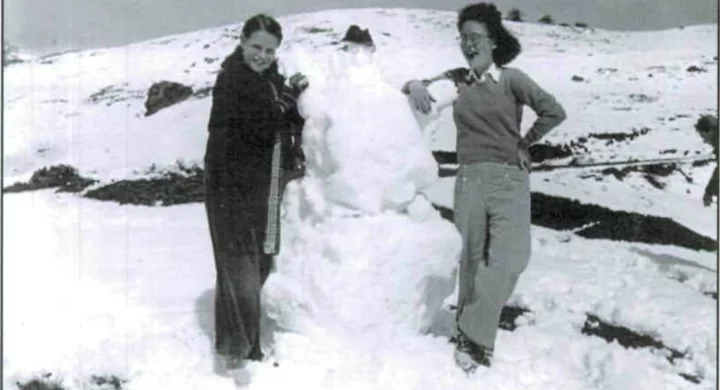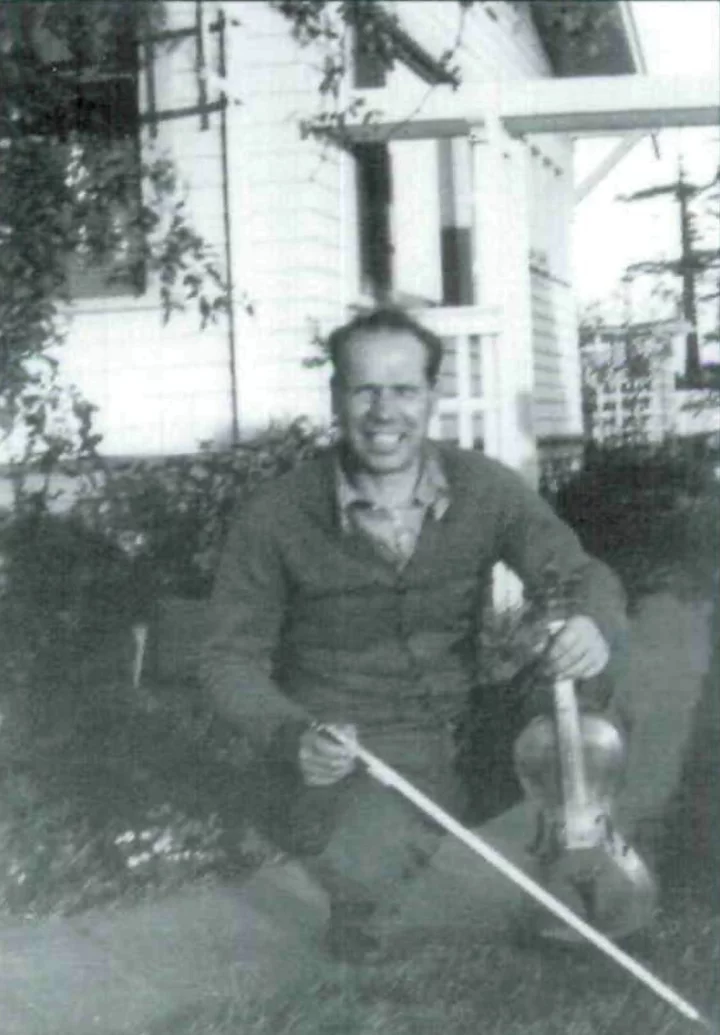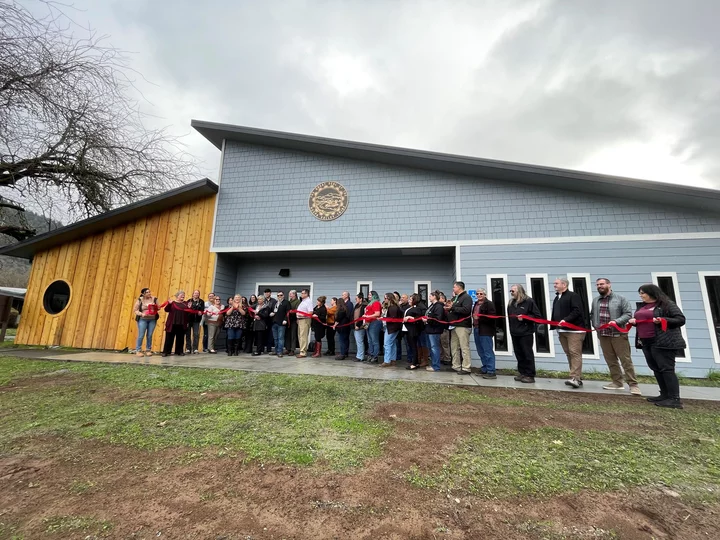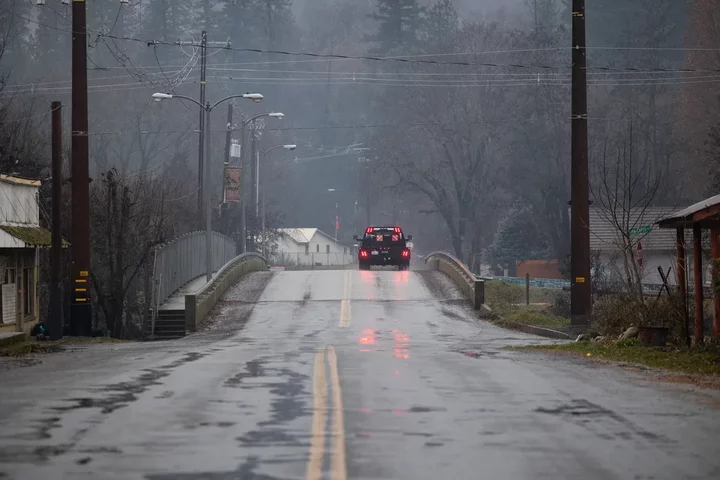What Do You Call That Little Island in the Middle of Arcata Bay?
Isabella Vanderheiden / Saturday, Dec. 21, 2024 @ 12:35 p.m. / News
A bird’s eye view of “Sand Island” from Google Earth.
###
Have you ever noticed that little island out in the middle of Arcata Bay? At just 1.8 acres, it’s pretty easy to miss — only visible from the water’s edge when the sea lions sprawl on its shores.
For decades, local fishermen and hunters have referred to the small swath of land as “Sand Island,” but no one ever bothered to have the name added to the national Geographic Names Information System. A proposal submitted to the U.S. Board on Geographic Names earlier this year seeks to replace the unofficial name with “Skate Island” after the “skates that reside in Humboldt Bay surrounding the island,” the proposal states. (In this case, “skate” refers to a flat-bodied, cartilaginous fish, similar to a ray.)
The proposal, submitted by Blue Lake resident Jack Malast, asserts that most Humboldt County residents are oblivious to the island’s existence. “I believe it requires a name because it is a relatively untainted area of wilderness on the Humboldt Bay,” Malast wrote in the proposal. “Having a name would give people a little bit more of a reason to remember it, and to consider its existence.”
Renaming a geographical feature is a lengthy process. Before the proposal is submitted to the U.S. Board on Geographic Names for review, a federal employee has to get feedback from local stakeholders.
“Basically everyone I received feedback from thought the naming proposal should be denied,” Jeffrey Ferguson, a navigation manager with the National Oceanic and Atmospheric Administration’s Office of Coast Survey, wrote in an email to the Outpost. “That is the recommendation I made to the NOAA rep to the U.S. Board on Geographic Names.”
As you might guess, most of the people Ferguson spoke with said the little patch of land has always been referred to as Sand Island and felt it should stay that way.
“I’m not particularly supportive of the idea,” longtime fisherman Ken Bates wrote in an emailed statement to Ferguson. “The Sand Island that we are referring to in North Humboldt Bay, is a human-constructed artifact of sand and small gravels dredged from the channel adjacent to the Arcata Long Wharf back in the 1800s. … All of the oyster companies have referred to this artifact as ‘Sand Island’ and … [it] is also the name used by the duck hunting community.”
Bates added that “skates are a rarity” in Humboldt Bay, noting, “I don’t see how the name ‘Skate Island’ would be particularly descriptive of this place … why don’t we just keep the local name and call it Sand Island?”
Humboldt Harbor Safety Committee Chair Leroy Zerlang agreed, adding that fishermen, oystermen, hunters, bird watchers and even the Humboldt County Sheriff’s Office have called the bit of land Sand Island “for a very long time.”
“The little island is known as Sand Island and has been … as long as I can remember, and I’m old,” Zerlang wrote in an emailed statement to NOAA. “I would say it is Sand Island and should remain Sand Island.”
Ferguson made a recommendation to deny the proposal to the California Advisory Committee on Geographic Names, which met for its quarterly meeting on Dec. 13. The committee agreed to forward Ferguson’s recommendation to the U.S. Board on Geographic Names for a final decision, though it’s not likely to pass.
“[H]owever, the official board could decide not to take my recommendation,” Ferguson noted. “I believe at this point, it still sits at the national level, and would be passed to the California Advisory Committee on Geographic Names for agreement or for the CA Board to argue they want to override the National recommendation.”
I know what you’re thinking. Who cares about naming a patch of sand in the middle of the bay? Most people don’t even know it’s there! I can’t even see it from the shore! Well, it’s mostly for the seafaring folk.
“NOAA typically cares most about names that appear on our nautical charts,” Ferguson said. “We want to avoid a name change causing confusion to mariners.”
The proposal is en route to the U.S. Board on Geographic Names, though it’s not clear when the board will make a decision. We’ll report back when we know more.
###
BOOKED
Today: 6 felonies, 10 misdemeanors, 0 infractions
JUDGED
Humboldt County Superior Court Calendar: Today
CHP REPORTS
Us101 N / Herrick Ave Ofr (HM office): Assist with Construction
ELSEWHERE
Humboldt Waterkeeper: Introducing the digital Humboldt Bay Water Trail Map!
Governor’s Office: ICYMI: Voter-approved Prop 1 funding awarded to communities to create new supportive housing to reduce homelessness
KINS’s Talk Shop: Talkshop August 25th, 2025 – Rob Arkley
EcoNews: August 2025 | Plankton Monitoring
THE ECONEWS REPORT: What Gives You Hope?
The EcoNews Report / Saturday, Dec. 21, 2024 @ 10 a.m. / Environment
Photo by Engin Akyurt via Pexels.
Environmentalists have a reputation for being a bit too doom-and-gloom. But what gives us hope?
Jen Kalt of Humboldt Waterkeeper, Alicia Hamann of Friends of the Eel River, Colin Fiske of the Coalition for Responsible Transportation Priorities and Tom Wheeler of the Environmental Protection Information Center join the show to discuss the things that give them hope.
Need a dose of hope?
- Public Transit Wins Big in Local Elections
- California’s Pace of Emissions Cuts Is Accelerating, Report Finds
- Eel River Fish Counts
- Digawututklh Returned
“The EcoNews Report,” Dec. 21, 2024
(Sorry, no transcript this week.)
HUMBOLDT HISTORY: The Prettiest Tree
Naida Olsen Gipson / Saturday, Dec. 21, 2024 @ 7:30 a.m. / History
A winter scene at the Johnson Ranch in laqua, near Showers Pass. Photos via the Humboldt Historian.
My father always welcomed an opportunity to go back up into the hills of Showers Pass where he was born and raised, forty miles from our home in Eureka. The weekend before Christmas usually found us going there to cut a Christmas tree. Dad whistled a little tune as the car toiled up the mountain road in second gear, and in some steeper places, in first gear, while my sisters and I sat in the back seat and clung to each other and the hanging straps inside each door. The roads were mostly one lane, with occasional turnouts for passing. Drivers tooted their horns on curves to warn oncoming traffic. If two cars met on a steep part of the narrow mountain trace, the car coming downhill had to hack up to a wide spot to let the other car pass. When the road traversed a cliff on one side, high above the treetops, we girls shut our eyes tight until we had passed that part. Even so, we knew we were safe with our dad, who would never let anything harm us. Would our lives always be this secure? We thought so.
We traveled past Freshwater, where my father’s “little orchestra,” as he called his small band, played for grange dances. Then our car climbed up hairpin turns to Kneeland, and on up to the mountaintop where the road became more level and followed the ridge. Many of Dad’s childhood friends still lived up there. He always stopped at the different ranches to visit a few minutes or just say hello. Sometimes we went as far as the old Iaqua School house, another place where Dad’s musical group played for dances. On the west side of the ridge road, we passed hills covered in dry summer grass, dotted with an occasional spreading oak tree, the country my dad had grown up in and where he had learned to hunt. He was an outdoorsman who happened to have three daughters. No sons. At times friends would tease him about his lack of a son to go hunting with him, but my father always told them he was happy with his three girls. He would not trade us for boys.
We always wanted to take home some of the mistletoe that hung in clumps from the topmost branches of the oak trees, too high to reach. Dad would stop the car and take his twenty-two rifle from the trunk, load it, and shoot the mistletoe out of the trees. We took home the rubbery- leafed bunches trimmed with waxy, pearl-like berries, tied them with a red ribbon, and hung them in the doorways in case a prince charming should come along. We were such dreamers.
This photo was taken on a Christmas tree outing in 1942, when life was still secure and carefree for the Olsen girls. The author, Naida, is on the right. Her younger sister, Betty, is at left.
Douglas fir and redwood trees grew on the east exposure of the mountains. Maybe it rained more there, or there was less sunlight. This area seemed better suited to conifers. My older sister, Pat, was in charge of deciding which tree to cut. In her estimation, it had to touch the ceiling in the living room of our small 1920s-style bungalow on Harris Street. We found the perfect tree, sawed it down, and helped Dad tie it onto the top of the car for the trip home. There he built a stand from scraps of two by fours and carried the tree into the house. I always tried to help carry it, and he let me do that, although I was probably more hindrance than help. We set the tree beside the large front window in the living room.
My sisters and I decorated the tree. Pat knew exactly how to put on the colored lights: red, amber, blue, green. She draped ropes of silver tinsel from one branch to another. Then my little sister, Betty, and I could help with the ornaments our mother had wrapped carefully in tissue paper and saved from year to year; fragile, ornate tree baubles made from paper-thin glass in different shapes, and tinted in various colors. Betty and I each had a bell ornament made of the same thin material, that had been given to us by Amy Winston, who stayed with us on the rare occasions my parents needed to go somewhere without children. Betty’s glass bell was pink and mine was my favorite shade of soft green.
The final step in decorating our tree was to hang silvery icicles from all the branches, putting them on one at a time to be sure they would hang straight down and shimmer in the glow of the colored tree lights. This was a tedious job we soon tired of, but we kept at it, because icicles made the tree look so nice. Dad reached up to put on the top decoration — an ornament resembling the spires in Russian architecture: a round decorated glass ball with a tall point that touched the ceiling. Mother took a white sheet from her linen closet, shook it out and bunched it up around the base to simulate snow and to hide the wooden stand. Finally, our tree was decorated. We turned on the colored lights and stood back to admire our hard work. Beautiful. A Christmas tree out of a fairy tale.
There were not many presents under the tree during the 1930s, and we did not hang up our stockings to be filled, but Mother saw to it that everyone had something — all the aunts and uncles and grandparents — besides our own family of five. When we were very young, it was a tradition on Christmas Eve to go for a ride through the town after the dinner dishes were done and admire the outdoor lighting displays. Imagine our surprise when we came back home to find that Santa had been to our house while we were gone and had left gifts for my sisters and me under the tree. How could he have done that? How could we have missed him? It was a puzzle.
One year a few weeks before Christmas, our whole family dressed in our best clothes and went Christmas shopping in downtown Eureka. This was a rare occasion in the 1930s. At the Woolworth’s Five and Ten-Cent Store, we girls chose new ecru cotton stockings for Aunt Carrie, and a set of little juice glasses with oranges painted on them, and held in a green-painted wire rack, for our mother. A book for our father. Then we went to Lincoln’s Stationery Store on Fifth Street and climbed the steps to the toy balcony where Betty and I found large baby dolls with composition heads, arms and legs, and stuffed bodies. Their short, blonde hair was soft, and curly. Their eyes opened and closed, and they cried, “Mama,” when we tipped them back and forth. That Christmas, Santa left these baby dolls under the tree for us. Not until years later did I discover this was the very same store where my mother’s first doll had been purchased — her father’s hired man bought the doll for her, while she lay with a broken hip in the brand new Sequoia Hospital on Main Street.
We usually “had our tree” on Christmas Eve, because on Christmas morning, my mother was busy getting dinner ready in time to be served by two o’clock in the afternoon. After we had opened our gifts on Christmas Eve, Mother went back into the kitchen to chop prodigious amounts of celery and onion, ready to make stuffing for the turkey first thing in the morning. Pumpkin and mince pies had been baked that day with a tablespoon of spirits sprinkled over each mincemeat pie before the latticework crust went on.
In 1934, the Christmas I was seven years old, a Shirley Temple doll sat under the tree just for me, I loved Shirley Temple, read every book about her that I could get my hands on, and knew all about the playhouse in her back yard in Santa Monica, My doll sat under the Christmas tree with her curly top, her famous dimples, and her smile showing tiny white teeth. She was the most perfect doll a little girl could want — not too big, nor too small. She was just right. I carried her around with me all day. Eventually, walking by the dining room table, I noticed a box with my doll’s name printed on it. I ran to my mother and told her Santa forgot to take my doll’s box away with him. She laughed and hurried away with the box, but I knew right then who Santa Claus really was.
One Christmas, a few years later, Betty and I received special gifts from one of our father’s oldest friends, Clarence Haugen, whose children were grown and who lived alone. We included him in many family occasions. He was a sign painter by trade and had painted the sign with a huge fish — a steelhead — that could be seen for many years on Highway 101 going south near Loleta. That Christmas, he gave Betty and me art tablets of drawing paper, and boxes of water color paints, a thoughtful gift for children who liked to draw things.
As we girls grew older, Christmases changed, but the tree still always had to touch the ceiling. Pat always put on the tree lights. Dad always put on the top ornament. We discontinued the ride to view Christmas lights on Christmas Eve, as we all knew who Santa was. Besides, during the war years, outdoor lighting was kept to a minimum. But we still kept our tradition of singing Christmas carols. I loved the beautiful harmonies we sisters created when we blended our voices together. Although my father loved to play the violin while I played the piano, strangely enough, I do not recall that we ever played Christmas carols together.
Most of Dad’s time was spent earning a living for us in his gas station and auto repair shop, which was next door to our house. He usually went back out after dinner, and sometimes worked until two or three in the morning. He kept one of his violins out in his work shop, and sometimes, if he was working extra late to get a job out for somebody by the next day, he might stop, take the violin down from where it hung on the wall out of harm’s way, and play a little music to soothe his soul. On the evenings he did not have to go back out to the shop, he would play the violin he kept in the house. When Dad played his violin, it seemed that everything was all right. We were safe, wrapped in the soothing notes of his music.
A week before Christmas 1944, we had put up our tree once more. The tip touched the ceiling. The colored lights sent their rays reflecting from the silvery icicles in holiday splendor. My father had been ill for some months, although he still did his work. Mother spent more time in the shop helping where she could, not only keeping the books, but winding armatures for motors, and pumping gas for customers. The doctors had been treating Dad for stomach ulcers, but had finally decided it must be something else. He could not keep anything down. Everything he ate came right back up. Dad sat exhausted in the big overstuffed chair by the fireplace that day and admired our Christmas tree. He said he thought it was the prettiest tree we had ever had.
I never saw him again. Early the next morning. Mother took him to General Hospital, across Harris Street from our house. Exploratory surgery was done that day. Cancer was found choking off the colon. He was too weak to survive the surgery. My father didn’t like funerals. I had often heard him say after he had been to one, that he didn’t want everyone sad and carrying on when it was his time. No crying. He wanted some music and maybe even dancing to celebrate the wonderful life he had lived. He was only forty-six years old.
At the funeral the day before Christmas, I did not cry. My father had said not to cry, so I didn’t, although it was hard to keep back the tears. After the funeral we returned to our house that felt cold and empty without him. The prettiest tree we ever had stood in all its tinseled glory with packages underneath it.
Mother decided our father would have wanted us to open our gifts in his memory. I slowly opened my packages. The house was too still — too quiet. Where was the music he had wanted? There was no joy in the world without him.
Mike Olsen with his violin.
###
The story above is excerpted from the Winter 2009 issue of the Humboldt Historian, a journal of the Humboldt County Historical Society. It is reprinted here with permission. The Humboldt County Historical Society is a nonprofit organization devoted to archiving, preserving and sharing Humboldt County’s rich history. You can become a member and receive a year’s worth of new issues of The Humboldt Historian at this link.
Humboldt County Health Dept. and Hoopa Human Services Cut Ribbon on Newly Renovated Shared Building
LoCO Staff / Friday, Dec. 20, 2024 @ 2:09 p.m. / Health Care , Local Government , Tribes
Staff from the Hoopa Tribe, DHHS, Supervisor Madrone and Hoopa community members celebrate the opening of the newly renovated Tribal, county co-location at 68 Orchard St. in Hoopa. | Submitted.
Press release from the Humboldt County Department of Health and Human Services:
Wednesday, Dec. 18, was a day of long-awaited celebration, as staff from the Hoopa Valley Tribe’s Division of Human Services and the Humboldt County Department of Health & Human Services (DHHS) cut the ribbon on their new co-located space at 68 Orchard St. in Hoopa.
Hoopa Valley Tribal Vice Chairman Jordan Hailey said it’s “exciting” that the county and tribe will be working more closely. “I believe better relationships, closer ties and collaboration will help to better serve the community as a whole as best as we can,” he said. “I am really excited to see what the future brings.”
DHHS Director Connie Beck agreed and said the push to co-locate staff has been years in the making. “I first started working on this project with past Hoopa Human Services Director Millie Grant several years ago,” she said. “Seeing it come to fruition is absolutely amazing.
CWS Indian Child Welfare Act (ICWA) Program Manager Pamela Miller said, “The county and Tribe already work together and have a strong relationship, and this closeness in proximity will serve to make it stronger.”Prior to moving into the newly renovated facility, DHHS staff maintained an office at the K’ima:w Medical Center in Hoopa with one local employee. This move makes is possible for DHHS to have an Eligibility Specialist, Behavioral Health Clinician and four Social Workers, including two assigned to ICWA ongoing cases.
Over the years, it has been challenging for DHHS to hire individuals who could move to the Hoopa-area to work at these jobs, or find people who were already residents, and for years, staff from Eureka took turns commuting to and from Hoopa to cover the vacancies. The travel time reducing the amount of time staff could provide services. Today, all six staff currently housed in the Hoopa office also live in the surrounding areas.
Humboldt County Fifth District Supervisor Steve Madrone thanked the Hoopa community members, the Hoopa Tribal Council and all the staff involved. “What a beautiful day this is,” he said. “So many people have worked so hard to help make this happen. We at the county are honored to be part of this. Thank you for inviting us to be your partners.”
CWS Social Worker IV Ella Kane, who works out of the new Hoopa office on social worker recruitment and retention, is a lifelong resident of eastern Humboldt and a longtime social worker. “I see this co-location as a way to increase access to essential resources that are not always available when living in our rural community,” she said. “Hiring social workers who live in the community helps ensure they have an understanding of the unique needs and challenges the children and families experience.”
CWS Director Amanda Winstead echoed Kane’s sentiments. “A space like this lets Tribal and county staff work side-by-side in new ways to support children to stay safe in their family and community. This is another step in our collaboration and partnership with the Hoopa Tribe—I am so grateful and appreciative of all the work and persistence both Tribal and county staff have put in to make this happen.”
Kane agreed, saying, “This new co-location has been a long time coming. I am so thankful it is finally here.”
DHHS services available at the new Hoopa location include Child Welfare Services, Behavioral Health and assistance with CalWORKs, CalFresh, Medi-Cal and General Relief and Transportation Assistance programs.
MAXIMUM ENFORCEMENT! CHP Ramps Up DUI Patrols for the Holidays
LoCO Staff / Friday, Dec. 20, 2024 @ 1:52 p.m. / Crime
###
Press release from the California Highway Patrol:
SACRAMENTO – As families prepare to celebrate the holidays, the California Highway Patrol (CHP) reminds everyone to prioritize safety on the road. To keep travelers safe throughout the busy holiday season, the CHP is initiating the first of two statewide Maximum Enforcement Periods (MEP) this month to reduce traffic incidents by targeting unsafe driving behaviors and assisting motorists.
The CHP’s Christmas MEP begins at 6:01 p.m. on Tuesday, December 24, and continues until 11:59 p.m. on Wednesday, December 25. During this period, the CHP will increase patrols throughout the state to deter dangerous driving behaviors, including impaired driving, speeding, distracted driving and seat belt violations. The CHP also encourages the public to report unsafe drivers by calling 9-1-1.
“This time of year is about celebrating with family and friends, but it’s also a time when traffic incidents increase due to poor driving decisions,” said CHP Commissioner Sean Duryee. “Each of us has a role in making California’s roads safer. Let’s work together to keep this holiday season free of tragedy.” Last year, during the 78-hour Christmas MEP, 20 people lost their lives in crashes within CHP jurisdiction. In addition, CHP officers made over 900 arrests for driving under the influence.
Let’s make safety our top priority on the road! Buckle up, drive responsibly, and if you’re celebrating, always plan for a sober ride. Your thoughtful choices can help prevent crashes and keep California’s roads safe for everyone. Celebrate wisely and drive with care!
The mission of the CHP is to provide the highest level of Safety, Service, and Security.
Meat Quality Concerns Delay Northern California Commercial Crab Season Opener to Jan. 15
LoCO Staff / Friday, Dec. 20, 2024 @ 12:02 p.m. / Fish
Image by Kevin Cole, CC BY 2.0, via Wikimedia.
###
Press release from the California Department of Fish and Wildlife:
The California Department of Fish and Wildlife (CDFW) will open the commercial Dungeness crab fishery from the Sonoma/Mendocino county line to the U.S./Mexico border beginning Jan. 5, 2025, at 12:01 a.m. with pre-soak to begin on Jan. 2, 2025, at 8:01 a.m. This area (Fishing Zones 3, 4, 5 and 6) will be subject to a 50 percent trap reduction. The trap reduction is expected to reduce entanglement risk for humpback whales by decreasing the amount of gear and vertical lines in the water.
The Dungeness crab season in the Northern Management Area (Zones 1 and 2, California Oregon Border to the Sonoma/Mendocino county line) will be further delayed pursuant to Fish and Game Code Section 8276.2 due to the inability to conduct industry-sponsored meat quality testing. The season will automatically open on Jan. 15, 2025, at 12:01 a.m. under a 25 percent trap reduction in both Fishing Zones. A pre-soak period will begin on Jan. 12, 2025, at 8:01 a.m. The crab quality delay triggers the fair start provision under Fish and Game Code 8279.1. Under fair start a vessel is prohibited from taking, possessing onboard, or landing crab in an area previously delayed for a period of 30 days from the date of the opening if that vessel previously participated in other commercial Dungeness crab fishing areas (including those in Oregon and Washington) during the same season.
While Dungeness crab has historically been available in time for the holidays, the presence of whales in the fishing areas and entanglements in fishing gear have delayed the season opening in the last several years. Last season, the northern fishing zones opened on Jan. 5, while the central zones were delayed until January 18. Despite the shortened seasons, the California Dungeness crab fishery remains one of the State’s most lucrative, averaging close to $45 million per year over the last five years, consistent with historical averages.
“Making the decision on when to open the Dungeness crab fishery is never an easy one. It requires careful consideration of the need to protect endangered species while sustaining the livelihood of California’s fishing communities,” said CDFW Director Charlton H. Bonham. “My action today strikes a balance between the needs of the fishery and the needs of California’s marine species. Reducing the number of traps in the water is a successful management measure we have utilized before. Applying this protective and precautionary measure to the Northern Management Area allows the fishery to open as early as possible and will minimize the risk of entanglements statewide.”
Managing the fishery to also protect whales and sea turtles has become a collaborative effort between commercial and recreational fishermen, environmental groups, scientists, and agency partners. This year’s fishery opener builds off over five years of efforts that entailed close to 150 meetings of the Dungeness Crab Fishing Gear Working Group, more than 50 risk assessments, and aerial surveys covering more than 20,000 miles of California’s coast. The state has invested over $6 million to address entanglement risk through CDFW and the California Ocean Protection Council. These funds enabled the purchase and outfitting of electronic monitoring units for the fleet, line to support gear marking programs, the development and application of new tools to evaluate risk, and the expansion of alternative gear testing.
Lisa Damrosch, Executive Director of the Pacific Coast Federation of Fishermen’s Associations, said, “It is always a good thing when California’s commercial fishing fleet can get to work, delivering healthy, sustainable seafood to our communities. Delays are difficult, and fisheries management is becoming increasingly complex. Commercial fishing representatives remain committed to being productive partners in finding workable, long-term solutions, and we very much appreciate CDFW’s hard work and commitment to collaborating with the industry to set an opening date that balances harvest opportunities with the need to reduce risks to marine mammals.”
Any commercial Dungeness crab vessel fishing in or transiting Fishing Zones, regardless of fishing location, is subject to the 25 or 50 percent reduction based on the area transited. Additionally, vessels must have at least 25 or 50 percent of valid buoy tags for the current fishing season onboard and available for inspection by CDFW at all times. Commercial Dungeness crab vessels operating in all Fishing Zones must understand and comply with the restrictions detailed in the Director’s Declaration, which includes additional information about this gear reduction.
CDFW is also lifting the temporary recreational crab trap restriction, beginning Jan. 2, 2025, at 8:01 a.m., from the Sonoma/Mendocino county line to Lopez Point, Monterey County (Fishing Zones 3 and 4).
A Fleet Advisory remains in effect for both the commercial and recreational fishery for all Fishing Zones.CDFW encourages both the commercial and recreational crab fisheries to implement best fishing practices, as described in the Best Practices Guide and avoid setting any fishing gear in areas where whales or sea turtles are present. In addition, the commercial fishery is encouraged to remain vigilant for lost or abandoned gear throughout the fishing season. Permitted commercial Dungeness crab vessels are allowed to retrieve up to six derelict commercial Dungeness crab traps per fishing trip pursuant to Section 132.2, Title 14, California Code of Regulations. Derelict fishing gear may also be reported through CalTIP.
CDFW anticipates the next risk assessment will take place in mid-January 2025. For more information related to the risk assessment process, please visit CDFW’s Whale Safe Fisheries page.
For more information on the Dungeness crab fishery, please visit www.wildlife.ca.gov/crab. Please see this Frequently Asked Questions for more information about the commercial fishery.
How Far Northern California Counties Are Creating More Jobs for Young People
Fiona Kelliher / Friday, Dec. 20, 2024 @ 8:15 a.m. / Sacramento
A view down 2nd Avenue in Happy Camp on Dec. 13, 2024. Photo by Miguel Gutierrez Jr., CalMatters
People living in the northernmost reaches of California refer to their community as the “Redwood Curtain,” a nod to the region’s abundance of redwoods and natural beauty — but also its remoteness.
With a combined population of less than half a million people scattered across Del Norte, Siskiyou, Modoc, Humboldt, Trinity, Shasta and Lassen counties, the area faces relatively lower wages, extremist politics and brain drain, and fewer educational opportunities compared to other parts of the state.
Most of the seven northernmost counties have seen decreasing or stagnant population trends in recent years, U.S. Census Bureau data show, along with the outmigration of working-age young people.
But workforce development boards, local officials and employers are looking to shift that narrative, using one-on-one mentoring, paid training in growing industries, and inclusive recruitment practices to help young Californians find — and keep — jobs in the region they grew up in.
“Young people in our counties are looking at either leaving the area, or not. That’s the first choice they make,” said Heather Chavez, director of workforce programs at the NorTEC Workforce Development Board. “It’s unpopular if you’re not leaving high school to go to a four-year college. There’s definitely a stigma around that — it’s students, it’s teachers, it’s parents, it’s employers, it’s everyone.”
Within that landscape, part of Chavez’s mission is to find “great, great, great jobs” for young people who can’t afford to leave their hometowns, or who find themselves without a high school or higher education degree.
Funded largely by the federal Department of Labor, NorTEC, which stands for the Northern Rural Training and Employment Consortium, aims to improve education, employment and upward mobility across 11 northern counties.
NorTEC provides one-on-one intensive mentoring — plus financial support for bus passes, interview and work clothes, or supplies required by a training program — to those between 16 and 24 who aren’t in school. Last year, 267 people were enrolled in the program; twelve months later, 77% were still employed in industries ranging from food service, hospitality, tourism, seasonal forestry or recreation-related jobs, manufacturing and food processing and health care, Chavez said.

A counselor helps those who are seeking new job opportunities at the Humboldt County Library in Garberville on Feb. 8, 2023. Photo by Martin do Nascimento, CalMatters
The region’s data is mixed when it comes to population dropoff among young people. Between 2017 and 2022, northwestern Del Norte County lost up to 1.2% of its population in every age bracket between 15 and 59, while Humboldt, Lassen, Siskiyou and Trinity also saw losses among young workers, according to state Employment Development Department data. Shasta County, however — home to the roughly 93,000-person city of Redding and Shasta-Trinity National Forest — made gains among those between 15 and 44.
California overall has seen a declining population in the last few years, a result of the COVID-19 pandemic, low birth rates and relatively low levels of immigration, according to the Public Policy Institute of California.
In the far north, these trends are expected to increase the demand for health care, even as those jobs remain difficult to fill, according to Randall Weaver, a labor market researcher at the state employment department. In Modoc, for instance, about 30% of the county’s 8,500 residents are over the age of 65.
Five of the region’s top 10 employers were health care-related in the past year, Weaver said, while the industry also accounted for about 50% of the top 10 occupations with the most online advertisements. But lower wages and stereotypes of rural living — along with fewer resources for cutting-edge medical infrastructure — make it tough to compete with “larger institutions with deeper pockets” in the Bay Area or Los Angeles.
“There’s clearly demand,” Weaver said. “The question is whether some of the limitations have a dampening effect on the market, and keep the positions from getting filled.”
Employers want to grow the hiring pool by finding and nurturing local talent. Earlier this year, Lassen Community College in Susanville launched a registered nursing program, which the program director described as “strategically designed to meet the escalating demand” for nurses locally and across California. Meanwhile, the Alliance for Workforce Development, one of three services providers contracted by NoRTEC in the region, is helping to grow three in-house training programs with Lassen and Modoc health providers, which provide free, paid training for entry-level health care roles such as certified medical or nursing assistantships.

St. Joseph Hospital in Eureka on Aug. 21, 2019. Photo by Anne Wernikoff for CalMatters
The idea is not only to receive an education locally, but to “get jobs here, locally, that pay well,” said Kim Keith, the alliance’s director of youth programs. This autumn, a cohort of about a dozen students attended a $17 hourly certified nursing assistant training program, performing their clinical hours in-house at the Lassen Nursing and Rehabilitation Center.
Of course, not all of California’s far north is dealing with the same challenges. Coastal Humboldt, which has a relatively larger labor force and a four-year university, has attracted major recent investments in two offshore wind farms, along with a yellowtail kingfish farm, that officials hope will spawn permanent jobs.
But the county — which has the highest poverty rate of about 18% compared to the other six — is still “scraping and clawing” to recruit people into certain industries, including lawyers, engineers and law enforcement, said Zachary O’Hanen, the county’s director of human resources.
To combat that, O’Hanen’s team has spearheaded efforts to embrace “belongingness” and inclusivity in its recruitment tactics for the public sector, looking to attract the best talent in a county that is rapidly diversifying. The approach has shown anecdotal success in terms of a jump in applications to county positions and recent diverse hires, O’Hanen said.
And while the “Redwood Curtain” stereotypes may persist, the region has a way of pulling people back in: After moving away to Oregon, O’Hanen returned to Humboldt, craving access to nature, the snow, the coast, and the slower pace of life.
“You leave, because you want to see the world, and then you go, ‘Well, maybe the grass wasn’t greener,’” O’Hanen said.
###
CalMatters.org is a nonprofit, nonpartisan media venture explaining California policies and politics.










